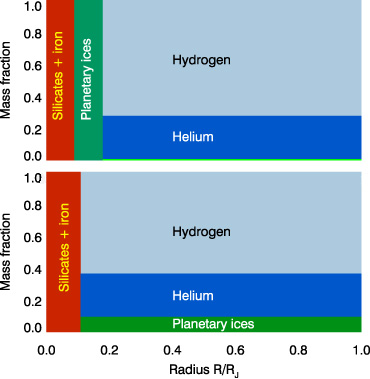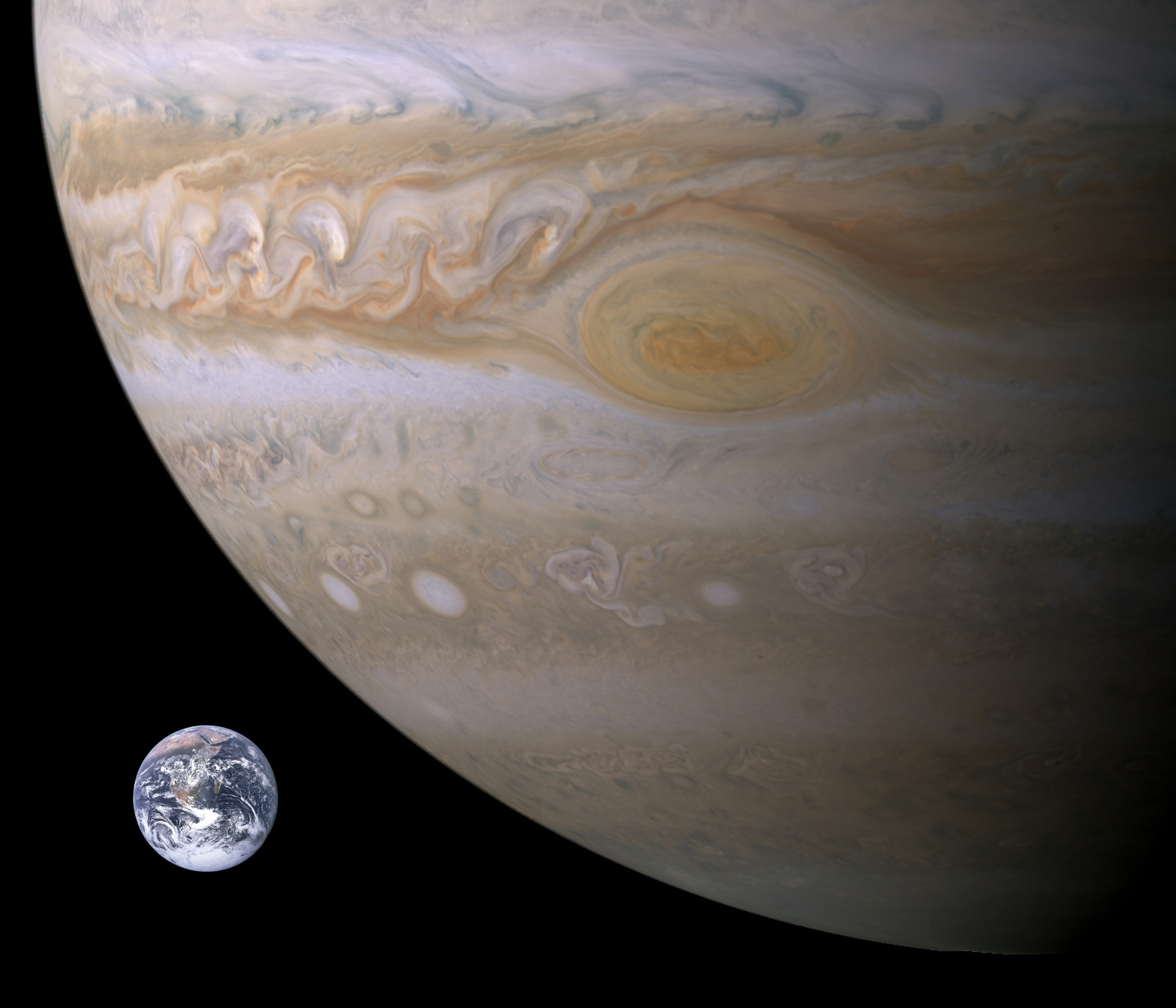[/caption]
Jupiter has a rocky core that is more than twice as large as previously thought, according to computer calculations by a geophysicist who simulated conditions inside the planet on the scale of individual hydrogen and helium atoms. “Our simulations show there is a big rocky object in the center surrounded by an ice layer and hardly any ice elsewhere in the planet,” said Burkhard Militzer from University of California, Berkeley. “This is a very different result for the interior structure of Jupiter than other recent models, which predict a relatively small or hardly any core and a mixture of ices throughout the atmosphere.” A comparison of this model with the planet’s known mass, radius, surface temperature, gravity and equatorial bulge implies that Jupiter’s core is an Earth-like rock 14 to 18 times the mass of Earth, or about one-twentieth of Jupiter’s total mass, Militzer said. Previous models predicted a much smaller core of only 7 Earth masses, or no core at all.
The simulation suggests that the core is made of layers of metals, rocks and ices of methane, ammonia and water, while above it is an atmosphere of mostly hydrogen and helium. At the center of the rocky core is probably a metallic ball of iron and nickel, just like Earth’s core.
“Basically, Jupiter’s interior resembles that of Saturn, with a Neptune or Uranus at the center,” he said. Neptune and Uranus have been called “ice giants” because they also appear to have a rocky core surrounded by icy hydrogen and helium, but without the gas envelope of Jupiter and Saturn.

“This new calculation by Burkhard removes a lot of the old uncertainties of the 19-year-old model we have had until now,” said coauthor William B. Hubbard from the University of Arizona. “The new thermodynamic model is a more precise physical description of what’s going on inside Jupiter.”
The large, rocky core implies that as Jupiter and other giant gas planets formed 4.5 billion years ago, they grew through the collision of small rocks that formed cores that captured a huge atmosphere of hydrogen and helium.
“According to the core accretion model, as the original planetary nebula cooled, planetesimals collided and stuck together in a runaway effect that formed planet cores,” Militzer said. “If true, this implies that the planets have large cores, which is what the simulation predicts. It is more difficult to make a planet with a small core.”
In order to match the observed gravity of Jupiter, Militzer’s simulation also predicts that different parts of Jupiter’s interior rotate at different rates. Jupiter can be thought of as a series of concentric cylinders rotating around the planet’s spin axis, with the outer cylinders – the equatorial regions – rotating faster than the inner cylinders. This is identical to the sun’s rotation, Militzer said.
The researchers say their model matches up well with data from the Galileo spacecraft, which orbited Jupiter from 1995 -2003.
Militzer plans to use the new model to simulate other planets’ interiors, and to investigate the implications for the formation of planets outside our solar system. Future data from NASA’s Juno mission, to be launched in 2011 and orbit Jupiter by 2016 to measure the planet’s magnetic field and gravity, will provide a check on Militzer’s predictions.
Source: UC Berkeley


I think this is fascinating. With so much pressure on the core, would it not be materials we have never seen? A huge diamond?
Nope, Jupiter isnt nearly massive enough to create a material with the density of a diamond. Study shows that several white dwarf stars however do have diamond-like material at their core. I quote:
Scientific evidence indicates that white dwarf stars have a core of crystallized carbon and oxygen nuclei. The largest of these found in the universe so far, BPM 37093, is located 50 light years away in the constellation Centaurus. A news release from the Harvard-Smithsonian Center for Astrophysics described the 2,500 mile-wide stellar core as a diamond.
I just don’t trust results based on computer simulations. You can get any results you want. I just ran my own simulation that strongly points to Jupiter’s core being composed of a giant dog turd.
I wonder if any studies have addressed rock and metal in the core of the sun… Sure, the sun fuses hydrogen to helium, but if the debris ring around the sun contained enough solid debris to form planets with metal cores, the sun should have a rocky and metallic core sitting underneath those processes… shouldn’t it?
Not to pick nits, but your image scaling is a little off. Jupiter’s diameter is 11.2 times that of Earth. Your image has it scaled at about 15 to 16 times Earth’s diameter.
But wait – in the Arthur C. Clarke 2001 novels, a giant piece of the diamond core of Jupiter wedges itself into some of the Galilean moons after the planet is turned into a sun by the Monolith ETI.
Are you saying that Clarke novels are just science fiction?
When I was a kid, Jupiter’s core was surrounded by ice thousands of miles thick, so it’s nice to have some of my childhood back thanks to modern science.
This tells me that analyses of spacecraft trajectories are insufficient to determine the internal mass distribution of planets, otherwise, with the flybys of the Pioneers 10 & 11, Voyager 1 & 2 and New Horizons, and the long-term orbiting of Galileo, this distribution would have been pinned down more precisely. I had thought this knowledge to be better in hand. So apparently we can conduct highly precise celestial billiards with our spacecraft without detailed knowledge of the internal planetary mass distributions.
I have long suspected that Jupiter has a rather large rocky-metal core. It would seem to me that a massive ball of rock and metal would have an easier time accumulating hydrogen, especially since jupiter has large rocky moons that have apparently been there just as long.
This may help to determine the minimum mass required to keep a thick hydrogen/helium atmosphere, which can help us figure out the composition of certain extrasolar planets.
Happy Thanksgiving Day!
I knew it.
I will never forget Chesley Bonestell’s exquisite illustrations of the surface of Jupiter, i.e., on that rocky core, or Clifford Simak’s stories of transformed dogs and men gamboling joyously on Jupiter. These new models of Jupiter’s core, i.e., solid surface, bring them to life all over again. 🙂
While ‘rock’, ‘ice’, ‘metal’ etc. are correct in terms of chemical composition, I think they’re misleading in terms of physical state: thus, by ‘ice’ they mean ‘superheated steam’, and the equivalent for the other components.
I don’t think this work implies a solid surface, just that the composition of the hot fluid changes as you go down, and more of the total would be made of heavy elements than was previously thought.
Ice…..On Jupiter…..Right. Next thing you know, computers will be saying theres lakes of ice on the sun.
I find it hard to understand how Jupiter COULDN’T have a rocky/metalic core. It is, after all, a humungous gravity well: a garbage pail for the solar system. Given that we have actually WATCHED a comet disintegrate under it’s gravitational influence, and then enter the Jovian atmosphere, and given that there have been some 4+ BILLION years for this to have happened over anc over and over and over again, it would seem OBVIOUS that any stony/metallic bits and pieces would collect “at the bottom”.
If, as seems to be the case, the early solar system had a whole lot of “trash” – planetesmals, etc. “roaming around”, why shouldn’t Jupiter have collected its fair share? That is, if it didn’t start out with a whole lot of solids to begin with…
Vague: Ice is ice, and its solid.
Neil: Can we see the results from your dog turd simulation? Or are you just a sarcastic moron?
quote=Bill “This tells me that analyses of spacecraft trajectories are insufficient to determine the internal mass distribution of planets, otherwise, with the flybys of the Pioneers 10 & 11, Voyager 1 & 2 and New Horizons, and the long-term orbiting of Galileo, this distribution would have been pinned down more precisely.”
Precisely. We can’t pin down the love numbers on Jupiter or Mars.
I suspect this new model is motivated by the growing number of observations that tell us the outer solar system is littered with heavy elements.
zachb: i was just trying to be funny ya douche
For what it’s worth I’ll quickly say that I believe that Jupiter has a mega ocean of liquid water , the surface of which lies about 180 miles below the visible cloud tops. I base this upon the results of the Galileo probe, the Shoemaker-Levy Comet impact observations, and my research into the equations of state– as poorly known as they are. After years of gas giant baloney it doesn’t surprise me that they now talk about ice on top of a rocky core. My main point is that if any planet has liquid water oceans it is surely Jupiter (and Saturn for that matter). I am quite sure that Jupiter is rife with life. Even without oceans! Look at the colors and the details in the atmosphere. And as algae and life have even affected the plate tectonics of this planet so goes the layers of Jupiter.
People go on and on about life on Jupiters moons—look at the planet folks! I hope the next probe we send in has cameras on a gradually descending balloon . And I don’t think it was neccessary to ditch Galileo and it’s plutonium packs into the planet the way they did! A rather cavalier and wreckless an action.
thats very nice photo.. ilove jupiter.. i wanna live in there.. 🙂
U GUYZ SUCK!!! HAHAHHAHA IM DOING A REPORT ON JUPITER!!!